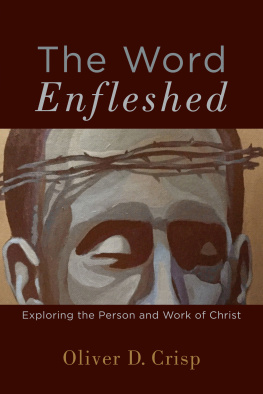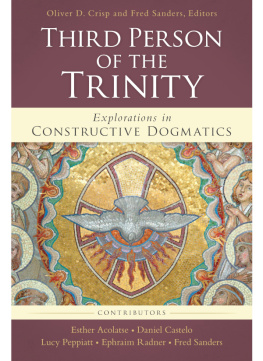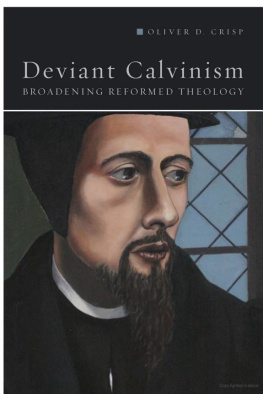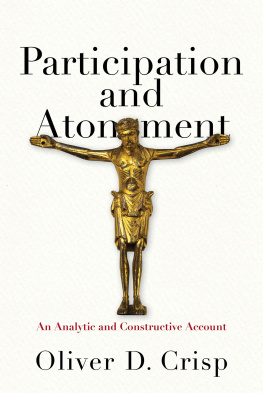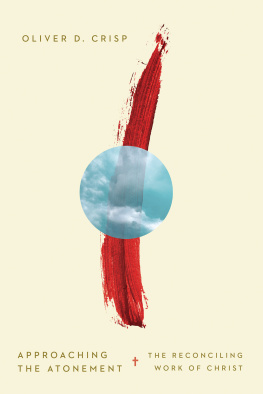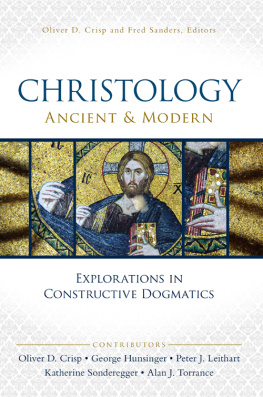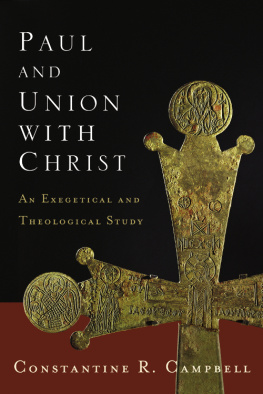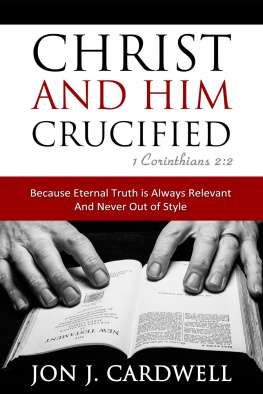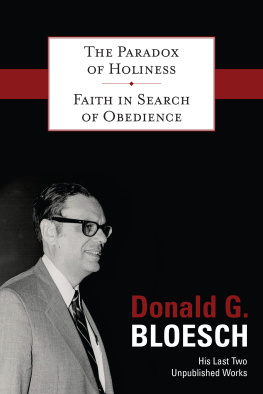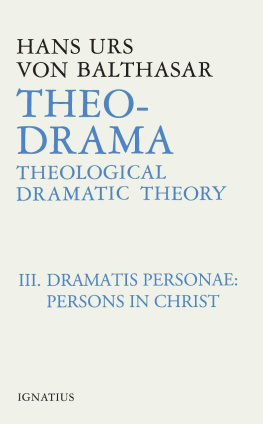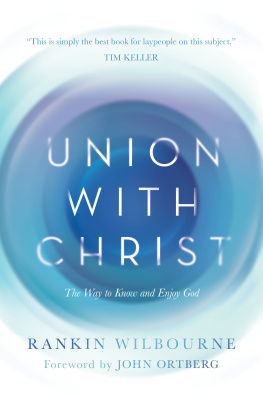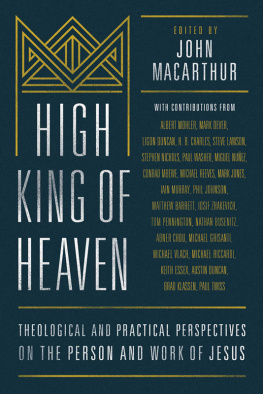Oliver D. Crisp - The Word Enfleshed: Exploring the Person and Work of Christ
Here you can read online Oliver D. Crisp - The Word Enfleshed: Exploring the Person and Work of Christ full text of the book (entire story) in english for free. Download pdf and epub, get meaning, cover and reviews about this ebook. year: 2016, publisher: Baker Publishing Group, genre: Religion. Description of the work, (preface) as well as reviews are available. Best literature library LitArk.com created for fans of good reading and offers a wide selection of genres:
Romance novel
Science fiction
Adventure
Detective
Science
History
Home and family
Prose
Art
Politics
Computer
Non-fiction
Religion
Business
Children
Humor
Choose a favorite category and find really read worthwhile books. Enjoy immersion in the world of imagination, feel the emotions of the characters or learn something new for yourself, make an fascinating discovery.
- Book:The Word Enfleshed: Exploring the Person and Work of Christ
- Author:
- Publisher:Baker Publishing Group
- Genre:
- Year:2016
- Rating:5 / 5
- Favourites:Add to favourites
- Your mark:
- 100
- 1
- 2
- 3
- 4
- 5
The Word Enfleshed: Exploring the Person and Work of Christ: summary, description and annotation
We offer to read an annotation, description, summary or preface (depends on what the author of the book "The Word Enfleshed: Exploring the Person and Work of Christ" wrote himself). If you haven't found the necessary information about the book — write in the comments, we will try to find it.
The Word Enfleshed: Exploring the Person and Work of Christ — read online for free the complete book (whole text) full work
Below is the text of the book, divided by pages. System saving the place of the last page read, allows you to conveniently read the book "The Word Enfleshed: Exploring the Person and Work of Christ" online for free, without having to search again every time where you left off. Put a bookmark, and you can go to the page where you finished reading at any time.
Font size:
Interval:
Bookmark:
2016 by Oliver D. Crisp
Published by Baker Academic
a division of Baker Publishing Group
P.O. Box 6287, Grand Rapids, MI 49516-6287
www.bakeracademic.com
Ebook edition created 2016
All rights reserved. No part of this publication may be reproduced, stored in a retrieval system, or transmitted in any form or by any meansfor example, electronic, photocopy, recordingwithout the prior written permission of the publisher. The only exception is brief quotations in printed reviews.
Library of Congress Cataloging-in-Publication Data is on file at the Library of Congress, Washington, DC.
ISBN 978-1-4934-0588-6
Scripture quotations labeled ESV are from The Holy Bible, English Standard Version (ESV), copyright 2001 by Crossway, a publishing ministry of Good News Publishers. Used by permission. All rights reserved. ESV Text Edition: 2011
Scripture quotations labeled NIV are from the Holy Bible, New International Version. NIV. Copyright 1973, 1978, 1984, 2011 by Biblica, Inc. Used by permission of Zondervan. All rights reserved worldwide. www.zondervan.com
Scripture quotations labeled NKJV are from the New King James Version. Copyright 1982 by Thomas Nelson, Inc. Used by permission. All rights reserved.
Scripture quotations labeled NRSV are from the New Revised Standard Version of the Bible, copyright 1989, by the Division of Christian Education of the National Council of the Churches of Christ in the United States of America. Used by permission. All rights reserved.
Chapter 3 is a revision of Oliver D. Crisp, Incorporeality, in The Routledge Companion to Philosophy of Religion , ed. Chad Meister and Paul Copan (London: Routledge, 2012), 34455. Used with permission from Taylor & Francis.
Chapter 4 is a revision of Oliver D. Crisp, A Christological Model of the Imago Dei , in The Ashgate Research Companion to Theological Anthropology , ed. Joshua R. Farris and Charles Taliaferro (Farnham, UK: Ashgate, 2015), 21729. Copyright 2015.
To Mike Rea,
Mensch
Cover
Title Page
Copyright Page
Dedication
Preface
Acknowledgments
1. The Eternal Generation of the Son
2. Christ without Flesh
3. Incorporeality and Incarnation
4. The Christological Doctrine of the Image of God
5. Desiderata for Models of the Hypostatic Union
6. Compositional Christology
7. The Union Account of Atonement
8. The Spirits Role in Union with Christ
9. The Nature and Scope of Union with Christ
Bibliography
Index
Back Cover
The great New England Puritan Jonathan Edwards once said that in Christ we find an admirable conjunction of diverse excellencies. The more I think about it, the more his remark seems to capture something fundamental about my own fixation with the person and work of Christ. Edwards was speaking about the constitution of Christ himself when he wrote these words in a sermon entitled The Excellency of Christ. But it is not just that the incarnation instantiates in one entity an admirable conjunction of diverse excellencies: divinity and humanity, God Incarnate, and so on. It also provides the theologianindeed, anyone with a stake in the Christian religionwith a compelling topic for investigation and intellectual engagement, for the very idea that a human being might also be divine is as riveting as it is scandalous.
My previous forays into this area have sought to tackle issues bearing upon the metaphysics of the incarnation, or what one might call the philosophical underpinnings of the theological claims made by historic, orthodox Christianity about the person of Christ. This has involved trying to get at what the traditional two-natures doctrine might entail. (Very roughly, the two-natures doctrine is the view that Christ is a divine person who takes on a human nature in addition to his divine one, in order to bring about the reconciliation or union of human beings with God.) It has also involved reflecting on christological method, as well as more unexpected questions about such things as whether Christ had a fallen human nature, or whether the virginal conception of Christ has any bearing on the medical-ethical quandary about the status of the embryo, or even whether there could be more than one incarnation. At the same time I have also developed an interest in the atonement as the culminating aspect of the work of Christ. To date, the results of my work in this area have been more scattered and occasional, but I hope to remedy that in a sequel to this volume, on the nature of the atonement.
This work is a further contribution to Christology. It is a study in systematic theology written from the perspective of analytic theology. On my way of thinking, analytic theology utilizes the tools and methods of contemporary analytic philosophy for the purposes of constructive Christian theology. Often, analytic philosophy is regarded as an enterprise that is not particularly interested in the origin or development of an idea, only in its utility, or its approximation to the truth of the matter. By contrast, Christian theology is usually thought to be deeply entangled with the genealogy of ideas. It is not just that for many theologians the origins and development of particular notions in the Christian tradition are as important as how we use such notions today. It is also that one cannot present theological arguments without paying attention to the ways in which the ideas contained in these arguments have been shaped by the Christian tradition. One cannot separate out the history from the concepts like the kernel from the husk without doing violence to the subject matter of theology.
Theologians have always been concerned to pass on the deposit of faith committed to them. Analytic theology can certainly be pursued in a way that seriously engages the Christian tradition. Indeed, this is how it is commonly practiced. Nevertheless, there is still a popular perception that analytic theology is an ahistorical project not interested in the genealogy of ideas or the ways in which ideas of the past influence our current thinkingan accusation that brings it under suspicion in the eyes of many systematic theologians. Work being done at the cutting edge of analytic theology shows this accusation is wide of the mark, though, as is often the case, these results take time to filter down to the popular imagination. This project is a small contribution to that literature, providing one instance of analytic theology that (I hope) is historically and theologically engaged. It is also written from the perspective of the Reformed tradition, which inevitably shapes the work in important respects, though it addresses thinkers from other theological traditions as well.
One of the main aims of this work is to provide a joined-up account of the person and work of Christ. There are books on the incarnation and books on the atonement; this is a book that treats the incarnation and atonement as two parts or phases of one divine workwhich is what I mean by a joined-up account. The atonement is the mediatorial work of Christ, but it is not the whole of the work of Christ. We might say that the atonement is a culminating moment of the work of Christ, a work that begins in eternity and is executed in time in the life and action of Christ in history.
With this in mind, the book begins with protological issues, matters pertaining to first thingsthat is, first things as applied to the person and work of Christ . To this end, chapters 13 deal with the eternal generation of the Son, the preexistence of Christ, and the relationship between divine incorporeality and incarnation. The first two of these topics have been the subject of some dispute in recent evangelical and systematic theology. The last involves an important cluster of issues about the relationship between God and the world that are much discussed in contemporary theology (viz., panentheism, emergence, and so on). I argue that the traditional, catholic notion that the Second Person of the Trinity is eternally generated by the Father should be upheld, contrary to some recent evangelical criticisms of that doctrine. I also argue that God the Son exists asarkos , or without flesh, prior to the incarnation. However, this raises worries about the relationship between Gods incorporeality and Christs corporeality. The third chapter addresses this concern, arguing that God is indeed incorporeal and that the assumption of human nature by the Second Person of the Trinity does not compromise this claim.
Font size:
Interval:
Bookmark:
Similar books «The Word Enfleshed: Exploring the Person and Work of Christ»
Look at similar books to The Word Enfleshed: Exploring the Person and Work of Christ. We have selected literature similar in name and meaning in the hope of providing readers with more options to find new, interesting, not yet read works.
Discussion, reviews of the book The Word Enfleshed: Exploring the Person and Work of Christ and just readers' own opinions. Leave your comments, write what you think about the work, its meaning or the main characters. Specify what exactly you liked and what you didn't like, and why you think so.

